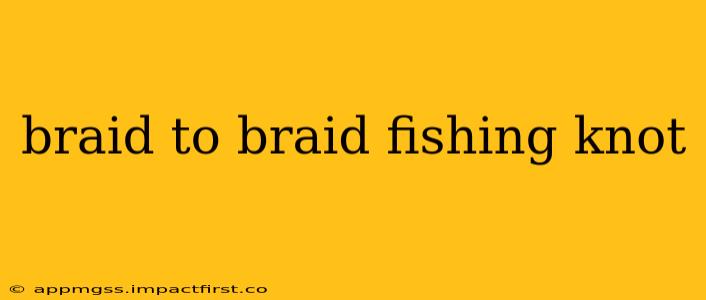Connecting two braided fishing lines requires a knot that's both strong and reliable, especially when targeting powerful fish. The wrong knot can lead to heartbreaking breakoffs and lost catches. This comprehensive guide explores the braid-to-braid fishing knot, focusing on techniques, strengths, weaknesses, and frequently asked questions. We'll cover several popular options, helping you choose the best knot for your specific needs and fishing style.
What is the Best Braid to Braid Knot?
There's no single "best" braid-to-braid knot, as the ideal choice depends on factors like line diameter, fishing conditions, and personal preference. However, some consistently rank highly for strength and ease of tying:
-
The Albright Knot: This is a popular and reliable choice, known for its high strength and relative ease of tying. It's a go-to for many anglers due to its simplicity and effectiveness.
-
The Double Uni Knot: A slightly more complex knot, the Double Uni offers excellent strength and is particularly suitable for smaller diameter braided lines. While slightly more difficult to master, the increased strength makes it worthwhile for many anglers.
-
The Spider Knot: This knot is exceptionally strong and relatively easy to tie, making it a contender for the best overall braid-to-braid knot for many anglers. It is known for its ability to handle even the thickest braided lines.
How to Tie a Braid to Braid Knot (Step-by-Step for the Albright Knot)
The Albright knot stands out due to its strength and relatively simple tying process. Let's break down how to tie it:
-
Overhand Loop: Create an overhand loop in one of the braid lines, leaving a tag end of about 6 inches.
-
Insert and Wrap: Insert the end of the second braid line through the loop and wrap it around the standing line of the first braid, making 5-7 wraps. The more wraps, the stronger the knot, but excessive wrapping can make it difficult to cinch down.
-
Pass Through: Thread the end of the second braid line back through the loop created in step 1.
-
Moisten and Tighten: Wet the knot thoroughly. Gently pull both standing lines to tighten the knot. Be careful not to over-tighten, as this could weaken the knot.
-
Trim Excess: Trim the tag ends close to the knot.
How Strong is a Braid to Braid Knot?
The strength of a braid-to-braid knot depends heavily on the knot chosen, the line diameter, and the technique used to tie it. Properly tied knots like the Albright, Double Uni, or Spider Knot typically retain 85-95% of the original line strength. Improper tying significantly reduces knot strength. Always practice tying your chosen knot until you can consistently achieve a tight, secure connection.
What's the Easiest Braid to Braid Knot to Tie?
For many anglers, the Albright Knot provides the best combination of ease of tying and knot strength. However, practice is key to mastering any knot. Start with simpler knots and gradually move to more complex ones as you gain experience.
Which Knot is Best for Small Diameter Braided Line?
The Double Uni Knot is generally preferred for smaller diameter braided lines. Its design allows for a tighter, more secure connection than some other knots, minimizing the risk of slippage with thinner lines.
How to Improve the Strength of My Braid to Braid Knot?
Several factors contribute to knot strength:
- Proper Tying Technique: Practice makes perfect. Master the chosen knot's technique to ensure a secure and strong connection.
- Line Condition: Use fresh, undamaged line. Frayed or damaged line significantly weakens the knot.
- Lubricant: Applying a knot lubricant helps to reduce friction during tightening, leading to a stronger, smoother knot.
By carefully considering the different types of braid-to-braid fishing knots, practicing proper tying techniques, and using quality line, you can significantly improve the reliability of your fishing connections, leading to more successful fishing trips. Remember, a strong knot is the cornerstone of a successful fishing day.
